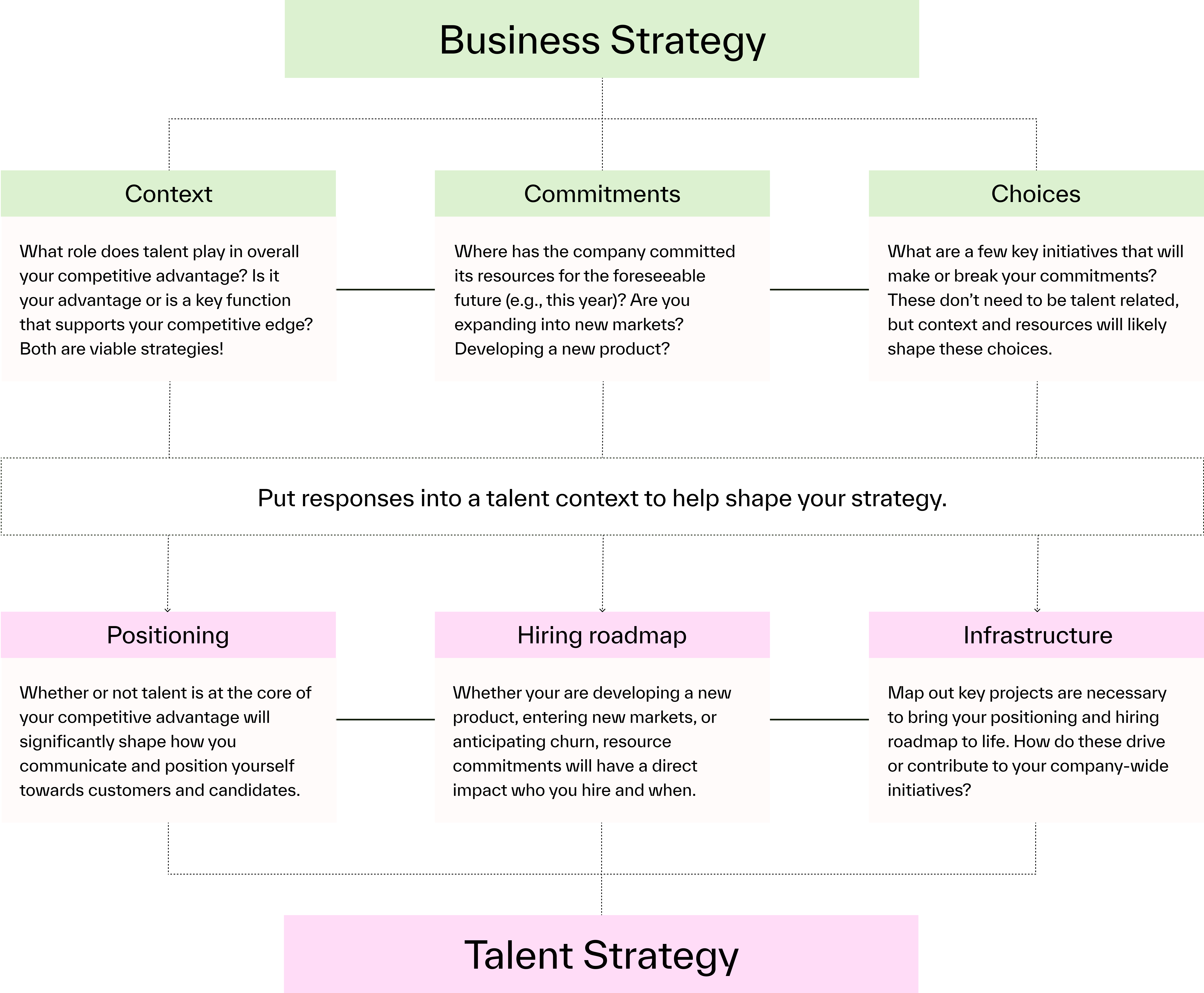
How to connect your talent strategy to your business strategy
From fundamental questions to frame-working exercises, let's get to the bottom of how you can actually connect your talent strategy to your business goals.
If you google "How to connect talent strategy to business strategy," you'll find many articles that look like this…
"Don't underestimate the role talent strategy plays in business strategy."
"Link talent management to business strategy"
"Talent leaders must understand the business context of the organization."
"Create Alignment with the organization's strategy."
…and all of that is true - and as a talent leader sitting in strategy meetings and board conversions, you know this is true. You know that you should connect your talent strategy to your business strategy. You know that you shouldn't underestimate the difference top talent makes in an organization. You know that you should have a clear direction that is aligned with other departments.
While some articles go more in-depth into these topics, most of them fail to mention how.
How do you ensure that your talent teams' actions today cover tomorrow's business needs? How do you know if your interview process, onboarding flow, employee experience, and hiring roadmap contribute to - and enhance - the goals and direction of the board and investors? How do you take your strategy beyond a list of budgets, to-do's, and deadlines? How can you act on a fluffy statement like "we want to be the preferred employer in our industry?”
This article will shed some light on how you can break down company direction into department goals and how to lift your head out of your to-do list and get some perspective on the bigger picture.
So, if you weren't googling "how to connect your talent strategy to your business strategy," you can now rest assured that you weren't missing out on some big "a-ha" moment that everyone knew about except you.
And with that said, let's dive into the how and hopefully uncover an a-ha moment (or two).
Decide what role talent plays in your competitive advantage
Is talent your competitive advantage, or is it supporting your competitive advantage?
You might be quick to say, "Of course, talent is our competitive advantage! We only hire the best."
First off, how do you know you're actually hiring the best? Unless you have a proven way to measure the effectiveness of your hires and the value they bring, or concrete definitions in your recruitment process that defines great talent, "hiring the best" is difficult to validate and measure. It's often proven after a hire has been made, but even then, you are only benchmarking performance against others in your organization rather than your competition or the market. So, how do you know that your competition’s talent team isn't also saying, "we only hire the best"?
Second, talent doesn't need to be at the center of your competitive advantage to be a critical function. You can maintain a focus on quality, drive critical strategic decisions, and move the business forward without your business' competitive advantage being talent.
Let's take a look at two examples…
Superside
When you go to Superide's website, they say things like "we hired the world's best creatives" or "we combine the top 1% of creative talent from around the world with…"
Setences like this make it very clear that Superside has put talent at the core of its competitive advantage.
This is a valid and successful strategy since Superside is both a product and a service company. They produce design at scale, which means they need quality designers delivering quality work day in and day out. Any deviation from this will negatively impact their reputation and, ultimately, their revenue. This is why it feels like a no-brainer to have talent at the core of their competitive advantage.
Pleo
When you go to Pleo's website, you'll need to do some digging or go to their career page before you see them talk about how great Pleo'ers are.
That's not to say Pleo doesn't hire top-tier talent. Nor does it mean they don't take recruitment seriously. They do. Take one look at their career page or book a demo, and you will see that they have a fantastic product and a unique employer brand. But that doesn't mean their competitive advantage lies within their talent team. Instead, they focused their competitive advantage on the outcomes and products their talented employees create.
The moral of the story is that Superside and Pleo are both wildly successful companies. Still, each takes a different approach to position their talent function in their organization.
Both are correct, and both are successful. It's just a matter of principle.
So, what are you? A Superside? Or a Pleo?
Find strategic clarity
This isn't where we step on our soapbox and tell you to align. Instead, this is where we give you some concrete questions to guide you on how to align.
Because the reality is that landing on your strategy is never easy, no matter how mature your organization is or how much funding and investors you have. If you're a large enterprise, processes are slow and top-down. If you're a Series C company, you've probably got a lot of cooks in the kitchen and many stakeholders you need to defend your strategy to. And if you're a start-up, you might still be trying to validate product-market fit, and answering that question is your strategy.
So while you can't necessarily control the stage your company is in and the situational complexities that come with it, you can control the questions you ask when allowed to align. Here are key questions you can use to help you get to the core of your strategy and build a plan that is connected, relevant, and pushing the needle.
- Where will the company be one year from now? Five years from now? The goal of this question is to get a general statement about the direction of your company. If you're used to the OKR model, consider this your objective.
- What skills and competencies are necessary for achieving the business objectives in the next quarter, year, and five years?
- Based on question two, which competency gaps exist in our current employees or will exist in the (near) future? Can we train them on these skills internally, or will we need to build entirely new teams externally? This will dictate which roles you are hiring and what their responsibilities are. This will ultimately shape the way you write your job descriptions, who you hire, and how successful they will be.
- Which of these skills and competencies matter more than the others? Not everything can be a priority, so make hard decisions about which competencies support your most critical outcomes.
- What roles have a disproportionate impact on value?
- How can we systematically build teams around individuals in these critical roles? Doing so will compound their value and create a flywheel of change.
- What has worked well in our recruitment process in the past? What hasn't? You can usually determine this through candidate feedback and candidate drop-off data. Check out this article on candidate NPS or designing candidate surveys to learn more about our take on these topics.
- What do our current employees love most about working here? What would they change? This will help you fix what isn't working and scale up what is.
- What is our current churn rate, and what are its main drivers? Be sure to factor in churn when setting your hiring targets.
- What are 3-5 critical initiatives or choices we can make today that will drive strategic focus over time? This will likely consist of more extensive projects like revamping your employer brand, switching your ATS, or setting up new learning and development tracks. These choices are absolutely necessary to bring your commitments to life.
Getting answers to these questions is super important, since it outlines the commitments and choices your organization plans to make in the foreseeable future. But their answers don't necessarily constitute a strategy. Their solutions make a list of bullet points, and it's your job to turn them into a stable framework you can lean on time and time again, leading us to our third and final point: frameworking.
Framework it
By this point, you should have clear answers around the following…
- Context - What role does talent play in your competitive advantage?
- Commitments - Where has the company committed its resources for the foreseeable future (e.g., this year)?
- Choices - What key projects do you need to take on to help drive the company in the right direction?
Let’s assume that you sat down with your team and asked them the 10 questions outlined in the previous section. Here are a few examples as to how you can structure the answers to these
Scenario 1: Expanding to a new market
- Your talent is a support function of your competitive advantage (context).
- You are expanding into a new market next this year (commitment).
- You have identified a handful of key initiatives, like working with an employment lawyer to handle new employee contracts, switching to a more GDPR-friendly ATS, and conducting salary research to benchmark your competitiveness in the new market (choices).
Scenario 2: Launching a new service.
- Talent is your competitive advantage (context).
- You are launching a brand new service this year, but in your current market (commitment).
- You will primarily hire front-end and back-end engineers, you will run employer branding activities to communicate that top talent lies at the center of your culture and success, you will run a series of workshops to rewrite job descriptions and interview guies so that you can rest assured your new hires will be able to successfully bring your new product to market (choices).
Knowing what role talent plays in your business, what goals your business has, and what initiatives your department needs to drive to realize those goals is critical. But unfortunately, doing a lot leg work without communicating your findings nor acting on them, means you put in a lot of effort just to end up with a bad strategy.
What exactly is a bad strategy? Author Richard Rumelt says bad strategy is something like this…
"Bad strategy is long on goals and short on policy or action. It assumes that goals are all you need. It puts forward strategic objectives that are incoherent and, sometimes, totally impracticable. It uses high-sounding words and phrases to hide these failings."
So how do you break down the fluff and avoid high-sounding words?
You framework it.
By frameworking it, we mean consolidating your conclusions around context, commitments, and choices. This could be in the form of a one-pager, a series of statements, a slide deck, or a visual model that distils your strategy to its core elements and highlights how you can act on these.
Here is an example of what connecting your talent strategy to your business strategy might look like in a visual model. We put key questions in the box, but you would put your answers to those questions there instead!

This exercise is useful for several reasons. First, it challenges you on how well you actually understand your strategy. If you can’t simplify it and explain it to a five-year-old, you might not understand it well enough. Secondly, it helps you connect the dots between what the talent team has decided to work on and the overall business direction - and using a model or a framework means you literally and visually connect the dots. Finally, it makes your department’s strategy (and value) easily understood by others without overwhelming them with details or forcing them to read through docs. It’s a quick way for engineers, sales, design, customer success, or anyone for that matter, to understand how the talent team brings value to the table.
What comes after a framework? To-do's, hiring roadmaps, and budgets - but we don't have the time to cover everything in this blog, so head over to Amby Labs to dive even deeper into the world of talent - and good luck!
.jpg)
Meagan Leber
Growth Marketing Manager at Amby, who loves writing about the tech, venture capital, and people space.
LinkedIn



